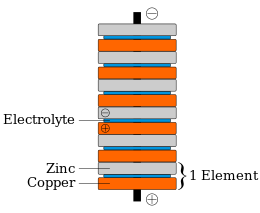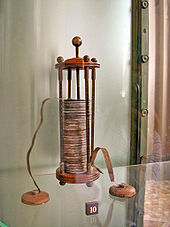
Back عمود فولتوي Arabic Вольтаў слуп Byelorussian Волтов стълб Bulgarian Pila voltaica Catalan Voltův sloup Czech Voltasøjle Danish Voltasche Säule German Βολταïκή στήλη Greek Volta sammas Estonian پیل ولتایی Persian
This article includes a list of general references, but it lacks sufficient corresponding inline citations. (December 2010) |



The voltaic pile was the first electrical battery that could continuously provide an electric current to a circuit.[1] It was invented by Italian chemist Alessandro Volta, who published his experiments in 1799.[2] Its invention can be traced back to an argument between Volta and Luigi Galvani, Volta's fellow Italian scientist who had conducted experiments on frogs' legs.[3] Use of the voltaic pile enabled a rapid series of other discoveries, including the electrical decomposition (electrolysis) of water into oxygen and hydrogen by William Nicholson and Anthony Carlisle (1800), and the discovery or isolation of the chemical elements sodium (1807), potassium (1807), calcium (1808), boron (1808), barium (1808), strontium (1808), and magnesium (1808) by Humphry Davy.[4][5]
The entire 19th-century electrical industry was powered by batteries related to Volta's (e.g. the Daniell cell and Grove cell) until the advent of the dynamo (the electrical generator) in the 1870s.[6]
- ^ "Battery: Voltaic Pile". americanhistory.si.edu. Retrieved 2024-05-12.
- ^ "Alessandro Volta | Biography, Facts, Battery, & Invention | Britannica". www.britannica.com. 2024-04-15. Retrieved 2024-05-12.
- ^ "The Voltaic Pile | Distinctive Collections Spotlights". libraries.mit.edu. Retrieved 2023-01-24.
- ^ Cite error: The named reference
Deckerwas invoked but never defined (see the help page). - ^ Russell, Colin (August 2003). "Enterprise and electrolysis..." Chemistry World.
- ^ "Alessandro Volta | Biography, Facts, Battery, & Invention | Britannica". www.britannica.com. 2024-04-15. Retrieved 2024-05-12.